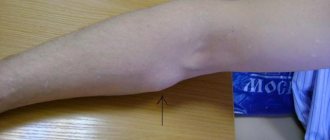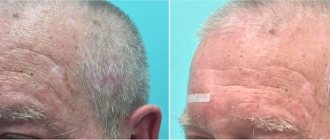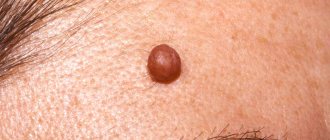Lipoma and skin atheroma are two common types of benign neoplasms. They require exceptionally attentive treatment, since in some cases (though, fortunately, not often) they can degenerate into malignant tumors. The appearance of atheroma may not cause suspicion - at first it usually does not cause much inconvenience. However, even if the tumor is not painful, you should still see a doctor. Often a lump (lipoma) on the neck or scalp gradually increases in size, in this case you need to visit a doctor urgently - the new growth will need to be examined to determine whether there is a risk of developing cancer.
Lipoma and atheroma are often similar in appearance, and patients often do not distinguish them from each other, defining them under the general name “wen.” Let's try to figure out what the difference is between a lipoma and an atheroma, and also what to do if you have one of these formations.
Lipoma
This is a benign formation consisting of adipose tissue. In essence, it is a local accumulation of adipose tissue under the skin. Lipoma is a benign tumor, although in rare cases, liposarcoma, a malignant formation, can develop under its mask.
Lipomas manifest themselves in the form of soft-elastic subcutaneous formations, mobile, painless, and can slowly increase in size. The skin over lipomas is not changed and easily moves over them. Small lipomas are not visible at all; they can only be detected by palpation. Larger lipomas stand out as “bumps” of round or oval shape. The size of lipomas is very variable - from 1-2 cm to 20 cm or more. Lipomas never become inflamed or suppurate.
Advantages of visiting our clinic
If you need removal of atheroma using the radio wave method in a clinic in St. Petersburg, then you can safely contact us. Our clinic employs highly qualified specialists with extensive experience who can competently diagnose and prescribe effective treatment. During their work, our ENT doctors use the most modern equipment to treat atheroma. We try to find an individual approach to each patient in order to take into account the characteristics of his body as much as possible. Our center employs highly qualified surgeons who can successfully remove atheromas without the risk of relapse. So, by contacting us, you can enjoy the following benefits:
- Consultation with a doctor with extensive experience.
- Competent diagnostics.
- Correct prescription of treatment.
- Treatment of atheroma is carried out using the most advanced technologies and modern equipment.
- Individual approach to each client and polite treatment.
- Favorable prices.
In addition, our center also employs pediatric ENT doctors , during whose appointments your children will not be afraid. You can find out more detailed information about how atheroma is removed using the radio wave method, prices and much more by contacting our employees by phone.
Atheroma
The origin of atheroma is fundamentally different from lipomas. Atheroma develops from the sebaceous glands of the skin. For various reasons, the gland duct becomes clogged, secretion accumulates in the gland, which gradually begins to increase in size. Atheroma is defined as a small (from 0.5 to 2 - 3 cm) formation, which always rises somewhat above the skin and is always fused to it (i.e. the skin above the atheroma does not move), and can grow slowly. Atheroma always has a capsule and contains atheromatous masses resembling crushed lard.
Because The atheroma is connected to the external environment by a duct; there is always a threat that it will become infected through the duct and suppuration will occur. In this situation, moderate pain appears in the area of the previously “quiet” atheroma, the formation quickly (over several days) increases in size, redness appears around it, and body temperature may rise. Suppuration of atheroma requires urgent surgery.
Sources of development
Common causes of atheroma formation are presented:
- hereditary predisposition;
- metabolic disorders at the cellular level;
- deviations in hormonal balance - changes in the content of estrogen, testosterone during gestation, menopause, during puberty or against the background of using hormonal drugs over a long period of time;
- stress – psycho-emotional instability leads to active production of sebum;
- increased sweating and violations of personal hygiene rules, the use of decorative cosmetics that cause allergies or other reactions;
- abuse of cosmetic procedures or the use of techniques that aggressively affect the condition of the epidermis;
- pinpoint damage to the sebaceous gland during the removal of acne and pimples;
- violations of the microbial composition of the skin;
- inflammatory processes in the dermis, including acne or rosacea;
- unfavorable influence of the external environment or working conditions.
These sources increase the risk of atheroma formation. The pathological process occurs only with prolonged effects on the dermis and sebaceous glands.
Symptoms
Identifying the problem in both cases is usually not difficult.
Signs of lipoma:
- mobile and painless, sizes can range from a few millimeters to 10-15 cm;
- to the touch - doughy or dense;
- not fused to the skin - the skin easily moves over the formation;
- never becomes inflamed – i.e. There is no redness or swelling of the skin above the lipoma.
Most often, lipomas are located on the limbs, head and torso; they are almost never on the face.
Removal of atheromas behind the ears.
Atheroma behind the ear can be removed in two ways:
- Laser;
- With a scalpel.
With traditional removal with a scalpel, after injection anesthesia, a skin incision is made to expose the atheroma. Then the cyst is removed along with its contents. The skin wound is sutured.
Rice. 3. Bursting atheroma behind the ear
It is clear that when working with a scalpel, a scar is left on the skin, comparable in size to the atheroma itself, and sometimes larger.
Laser technologies make it possible to remove atheroma entirely without a single drop of blood from a small puncture in the skin, which allows for the best possible cosmetic result.
Symptoms of atheroma
The formation is in the form of a tubercle, painless, mobile, fused to the skin, you can often see the opening of the excretory duct of the gland. Most often, the “bump” is located on areas of the body where there is hair: on the face, scalp, in the genital area, on the legs, on the back, and is found on the face. If a suppurating atheroma appears, the formation increases in size over several days, the skin on the affected area may turn red and become painful, and the temperature may also rise.
Clinical picture
When consulting a dermatologist, the patient undergoes a standard examination. Visually, the doctor determines the presence of a neoplasm with high mobility and absence of painful sensations during pressing. In the absence of complications, the skin over the cyst remains unchanged; sometimes an enlarged sebaceous duct is clearly visible in this area of the dermis.
If atheroma is characterized by rapid development, then small ulcerations may appear on the dermis. When an infection occurs and the subsequent development of the inflammatory process, the skin becomes red.
Atheroma without inflammation and secondary complications does not affect the life and health of the patient. Most patients seek professional help for aesthetic purposes. In other cases, surgical intervention becomes a necessary measure to stop developing inflammatory processes with the accumulation of purulent contents.
Treatment
Now that we have figured out the difference between a lipoma and an atheroma, let’s move on to the next question: is it necessary to remove the lipoma or remove the atheroma? Let's start with the fact that conservative treatment of lipoma, as well as treatment of atheroma, is absolutely futile. Moreover, aggressive influence on these formations using various “folk” remedies can cause suppuration of atheroma, as well as malignancy (malignancy) of lipoma.
Tactical approaches to the treatment of lipoma are as follows: if the lipoma is small (2-3 cm), does not grow and does not cause any inconvenience (does not rub against clothes, is not a cosmetic defect, etc.), then it does not need to be removed. In case of growth (especially rapid growth), it is better to go for surgery. If the lipoma grows, then sooner or later you will still have to remove it, but it is better to do this while it is small in order to avoid large incisions and traumatic intervention. Any removed lipoma should be sent for histological (under a microscope) examination.
As for atheroma, it is recommended to remove it in any case, because practice shows that sooner or later they fester, and during surgery against the background of inflammation it is not always possible to completely remove the atheroma capsule, which is fraught with relapse (reappearance of the formation). In addition, when suppuration occurs, the wound is almost never sutured; it heals by secondary intention, which often leads to the formation of a rough scar. If, after removing the atheroma, it turns out that the formation does not have a capsule and does not contain atheromatous masses, it should be sent for histological examination to exclude dermatosarcoma, which is sometimes similar in appearance to atheroma.
Possible complications
There are a number of consequences of atheroma:
- Risk of developing into phlegmon with an extensive abscess.
- Risk of relapse if opened independently.
- Risk of formation of suppuration and inflammation.
- The risk of postoperative scars that arise as a result of surgical removal of large atheroma.
- Inflammation of the scars may occur if the atheroma is removed in the clinic.
- As a result of incorrect diagnosis, a relapse may occur.
It is also worth noting that atheroma is a very rare disease; according to statistics, only 7-10% of the world's population gets sick with it. Atheroma is a benign neoplasm that never becomes malignant.
To sum up all of the above, we can say
- Lipoma and atheroma are benign formations of different natures - lipoma simply consists of altered adipose tissue, and atheroma is made of a sebaceous gland with a capsule filled with secretion - sebaceous atheromatous masses.
- Conservative, incl. Treatment of lipoma with folk remedies, as well as treatment of atheroma, is absolutely ineffective and often harmful.
- A small (2-3 cm) lipoma can not be operated on, but observed. In case of growth, as well as any discomfort, surgery to remove the lipoma is indicated.
- Removal of atheroma is always desirable, because they tend to increase in size and fester.
- If you find a subcutaneous formation in yourself, you need to consult a doctor, because... under the guise of a lipoma or atheroma, other formations can develop - dermatosarcomas, liposarcomas, hygromas, lymphadenitis, etc.
Dr. Elshansky I.V. has been involved in the diagnosis and surgical treatment of benign formations of the skin and subcutaneous tissue for many years.
Prevention
There are no effective methods of prevention. If there is increased secretion of the sebaceous glands, atheromas may appear in places near removed bumps or in new locations. As a preventative measure, you can eat less fatty and high-carbohydrate foods so as not to stimulate the glandular apparatus. Use antiperspirants as little as possible; your skin is oily. Use the right skincare products for your skin type to ensure that your pores are free of sebum.
Preventive measures
The risk of atheroma can be minimized by adjusting the rules of hygiene procedures, skin care and partly lifestyle. You should:
- Strictly observe personal hygiene, take a shower regularly, wipe the skin in the armpit area thoroughly and dry.
- If you are prone to excessive sweating due to one or another chronic thyroid disease or hyperhidrosis, use a high-quality antiperspirant.
- Balance your diet, do not exceed the daily intake of fats and carbohydrates (especially simple ones).
- Those with oily skin should choose professional daily care products that suit their skin type.
In addition to general methods of prevention, it is important to undergo routine examinations with a dermatologist, which, when pathology begins, will allow it to be identified at an early stage, to avoid complications and long-term treatment.










